(January 1927, 20m) Director: Fred Guiol Released: Path� Exchange, June 12, 1927 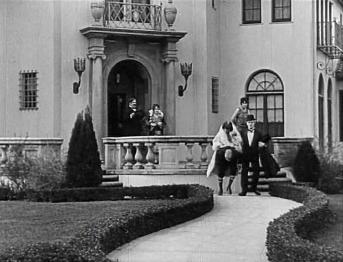 A selection of firsts as Love 'Em and Weep is not only the first Laurel and Hardy film to feature 'The Pink Pup' Caf� and the first to feature Stan's cry in full, but it's also the debut of James Finlayson, Mae Busch and Charlie Hall. Finlayson was born in Larbert, Scotland, on August 27 1887 and would appear in 34 films with Laurel and Hardy, as well as some foreign language remakes of their shorts, meaning he appeared in a third of their collaborations. Finlayson had first worked with Stan two years after The Lucky Dog to make a one-reeler entitled The Noon Whistle (1923). Between then and Love 'Em And Weep Stan and Finlayson had appeared in 18 shorts together. To this effect, Love 'Em And Weep isn't really a Laurel and Hardy film at all, but rather Laurel and Finlayson continuing their working relationship and Hardy a bit part player. Charlie Hall was less recognisable as a foil, and given less opportunity in their features, but for my money he was the funniest guy they had. He didn't have a bald head and comedy moustache, he didn't squint or have a 'D'ohhhhhhhh!' catchphrase and, apart from being less than 5'5 tall, he was a pretty generic looking kind of guy. Quite a dashing chap, I imagine, but he doesn't have a bald head, a double take, or an unusual voice - his English accent hidden beneath an amusing cod American one so as not to clash with Stan's. As a result he perhaps doesn't stick in the mind quite as much as Finlayson even though he appeared in more Laurel and Hardy films (47, as well as a handful of solo shorts with both men), yet when given the opportunity to shine, as in Them Thar Hills and Busy Bodies, to name but two, he really delivers on his promise. Finally, Mae Busch went on to appear in a dozen more Laurel and Hardy films, including memorable turns as a bullying wife in Sons of the Desert and Charlie Hall's wife who joins in with drunken songs in Them Thar Hills and Tit For Tat. Her role here as a woman who Finlayson's wife suspects of having an affair with her husband is given a layer of irony as Busch did, in real life, undertake an affair with producer Mack Sennett behind the back of his fianc� Mabel Normand. Unsubstantiated rumours that Busch physically assaulted Normand when discovered add an extra frisson to Busch's later violent onscreen personas. As for Love 'Em And Weep itself, then it's an okayish domestic comedy situation with Laurel as Finlayson's aide and Hardy in a very minor role behind a comedy moustache and glasses, but this particular short was far better when they remade it for sound as Chickens Come Home-.    (February 1927, 20m) Director: Fred Guiol Released: Path� Exchange, July 17, 1927 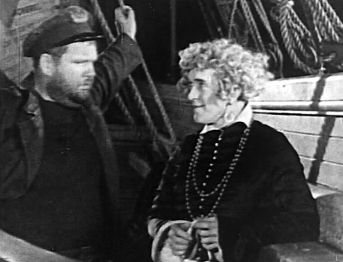 What's interesting about these early Laurel and Hardy films is that, while they may appear as characters very similar to their regular personas - Willie Brisling has a lot of mannerisms the same as Stan - they don't actually play 'Stan and Ollie' proper until Hats Off. Marking the difference further here is Hardy's character as a violent ship's first mate, an unshaven bully who spits and threatens in a role that lacks the actor's usual charm. Although Laurel and Hardy films were made in ostensibly more innocent times, much of the humour can be risqu� for the period. Here Stan dresses as a woman to entice sailors to their doom with the lure of sexual promise, while the bawdy ending sees he and his lover's clothes blown off by a gunshot, exposing their underwear. It's unusual for the team in hindsight, but definitely one of the best of the early, pre-character shorts.    (March 1927, 21m) Director: Fred Guiol Released: Path� Exchange, August 28, 1927 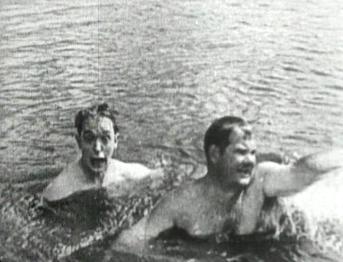 With Love and Hisses continues where Why Girls Love Sailors left off in terms of bawdy humour. Here the entire last reel is dedicated to Stan, Ollie and a platoon of soldiers all entirely naked, the final pay off being their swollen buttocks, courtesy of some superimposed 'bees'. These artifically enlarged backsides and a close up of Stan's sore toes bulging, balloon-like, in his shoe are the first time in a Laurel and Hardy movie that bodily pain was shown to have an unnaturalistic effect, a cartoonish reaction with the aid of props. From this point on it's simply a logical progression towards stretching necks (Way Out West) or twisted legs (Going Bye-Bye!), an extra string to their comic bow. In addition, the idea of primitive special effects to add the humour is also a continuation of Why Girls Love Sailors - there the comic book-like effects of a fight could be seen, here we have the pungent aroma of rotten eggs being animated.    (April 1927, 20m) Director: Hal Yates Released: Path� Exchange, September 25, 1927 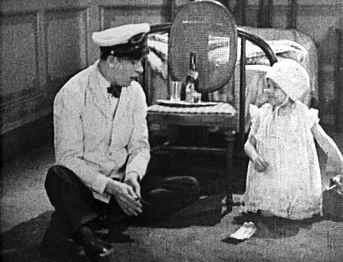 Possibly the least-focussed of their first dozen shorts, Sailors, Beware! Sees Stan as an innocent taxi driver embroiled in a ship robbery with a villainous female robber (Anita Garvin) and her midget partner dressed as a baby. The majority of the runtime sees Stan with the midget (Harry Earles), while Hardy is relegated to a support role as a bullying porter. After completing work on this short Stan immediately began filming Should Tall Men Marry? (released 1928) with James Finlayson. It was the final film that Stan did without Ollie, taking the total number of solo Laurel films to 63. At date of writing 49 of them are known to still exist, along with 6 partially surviving movies.    (April 1927, 20m) Director: James Parrott Released: Path� Exchange, October 5, 1927 Laurel and Hardy fans are blessed with what remains in the archives in many ways. Though the completely missing Hats Off is the Holy Grail of Laurel and Hardy, every other one of their movies exist in the archives, with just three only partially missing. Along with a few minutes of Battle of the Century and almost all of The Rogue Song, then Now I'll Tell One is one of those partially-missing shorts. Now I'll Tell One was actually a vehicle for Charley Chase with Stan and Ollie in minor roles and no shared screen time. Chase plays a man whose wife is divorcing him in court, Stan the lawyer defending him who makes Charley's case even worse. What makes the short so notable is that it uses the medium of flashback sequences, as well as a more defined plot structure than previous entries. If you wanted to be really flippant you could even suggest that the subject matter makes it Rashomon done over twenty years early. Chase had worked with both leads before - Stan was co-writer on Charley My Boy (filmed 1925), a starring vehicle for Chase, and assistant director on The Merry Widower (filmed 1926), in which Chase had an uncredited bit part. Meanwhile Chase had appeared with Hardy in a dozen shorts from 1918-1927, directing four of them, and had directed Hardy in a further seven films in which he himself did not appear (1918-1920). Stan and Ollie would go on to have small roles in a Charlie Chase short, with 1936's On The Wrong Trek, while Chase would be most famous to Laurel and Hardy buffs as the obnoxious convention goer in Sons of the Desert. Two months after making Now I'll Tell One all three would appear in Call of the Cuckoo. Born in Baltimore, 1893, Chase's real name was Charles Joseph Parrott, a vaudeville star who had entered movies in 1912 and appeared in ten films with Charlie Chaplin in 1914. He first began working for the Hal Roach studios in 1920 as a director, before becoming director general in 1921, overseeing everything except the Harold Lloyd works. He eventually returned in front of the camera and, like Laurel and Hardy, successfully made the transition to sound. While often overlooked today, Chase was highly successful at the time and a resurgence of interest in his work has taken place with the release of some of his shorts on DVD. Now I'll Tell One was directed by Chase's younger brother, James Parrott. Both Laurel and Hardy had worked with Parrott individually but had never appeared in the same picture under his guidance before. Parrott would go on to direct twenty-five Laurel and Hardy films in all, including highly regarded works such as The Music Box and Way Out West. James actually started out as an actor in shorts in 1917 under the pseudonym Paul Parrot, and had nearly 130 credits to his name before becoming a director. He could be seen in Laurel and Hardy's first feature, Pardon Us, as an uncredited marching prisoner. Sadly, both brothers met a tragic end - James died in 1939, aged 42, after becoming addicted to prescription drugs. Charles, who had refused to give his brother money for his dependency, felt responsible and developed a further reliance on the alcohol that had plagued most of his professional career. Charles's alcoholism eventually lead to his fatal heart attack in 1940, aged just 46. As what remains of this film only exists in poor quality and has yet to be released onto DVD I've taken the decision not to include an image from it on this site as the picture quality would be too poor. But of what remains of Now I'll Tell One, then it's well worth checking out.     (May 1927, 19m) Director: Fred L. Guiol Released: Path� Exchange, November 20, 1927 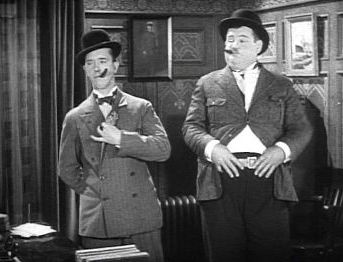 May 1927, and even though they were still three films away from being an 'official' pairing, Stan and Ollie here emerge almost fully formed. Playing a pair of clueless detectives out to protect James Finlayson's hapless judge, they go by different names - Ferdinand Finkleberry and Sherlock Pinkham - but are essentially in their soon-to-be-familiar personas. For the first time we not only get the waistcoats and derbies, but also the debut of one of their most familiar routines - Stan and Ollie putting on the wrong hat. What's surprising is that not only was this pairing not immediately capitalised on - they were still going under character names even nine months later - but that the following short was a radical change of style. Also notable is that both leads spend some of the runtime with (unlit) cigars in their mouths. Though not a regular part of their onscreen personas, both men were prolific smokers behind the camera and did a print advertisement for 'Old Gold' cigarettes in 1934. Stan in particular was a chain smoker until health issues caused him to quit in 1961. In an age where smoking was not only seen as a social activity but even a healthy pastime, then in 1931 both Stan and Ollie took part in a short (The Stolen Jools) for a Tubercolosis Sanatarium with Chesterfield Cigarettes as a sponsor.    (May 1927, 17m) Director: Frank Butler Released: Path� Exchange, February 12, 1928 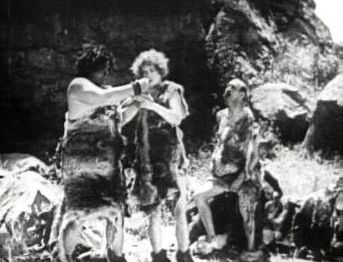 The most atypical Laurel and Hardy film of all, Flying Elephants (so named because of a five-second piece of animation with flying pachyderms) sees Stan and Ollie as the world's most inept caveman trying to mate in the prehistoric age. Shot on location in Moapa, Nevada, and rumoured to be personally directed by Hal Roach and not the credited director, Flying Elephants is something of a diverting mess. Stan and Ollie rarely share screentime, and most of their scenes together when they do finally meet are ones of conflict. Regardless, the content was hardly original, with Charlie Chaplin also struggling to get genuine laughs out of the caveman set-up over a dozen years earlier in the last of his so-so works for Keystone, His Prehistoric Past. Ultimately it's left to Buster Keaton - again, predating Flying Elephants, this time by over three years - to show how to make the format work for a comedy. 1923's semi-classic Three Ages constantly brims with wit and invention and is everything the form should be. Flying Elephants amuses from time to time, but it's far from Stan and Ollie at their best. The film's release was delayed after Hal Roach had switched to MGM as a distributor. Path� wanted to make the most of what they still had in their backlog and so released their remaining Laurel and Hardy product slowly.    (June 1927, 20m) Director: Fred L. Guiol Released: MGM, September 10, 1927 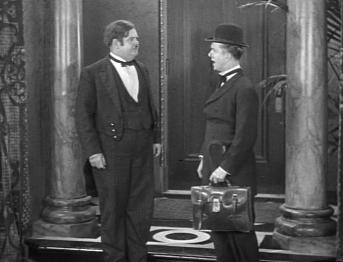 Sugar Daddies sees rich James Finlayson awake from a drunken night out, only to be told by his butler (Hardy) that he'd got married while intoxicated the night before. He rings his attorney (Laurel) to sort the whole mess out, only to be threatened with murder by his bride's psychotic brother. As a result all three men go on the run, with Stan dressed up as a woman on top of Finlayson's shoulders in a reprise of the routine from Love 'Em And Weep. In some ways Sugar Daddies can seem a little broad and lacking in direction, particularly as it comes just before a defining film like The Second Hundred Years. Things aren't helped by there being such a high number of title cards with captions and dialogue throughout. H.M. 'Beanie' Walker worked with the Roach studios until 1932 and was attributed with writing the dialogue for the sound films, yet his caption cards have a notably more 'arch' sense of humour that can get a little wearying at times. Altogether viewers are asked to sit through 37 title cards in this short, almost two per minute. (Another odd gag is the prominent story on the back of the newspaper the brother reads that offers an end of the month sale 'all day Saturday'. I assume the 'gag' is that Saturday wasn't the end of a month when the film was made or released, but... bit of a weak gag, eh?) Yet having said all this, Sugar Daddies can be amusing, and a fine example of the timing between the two stars. Just look at the moment where Stan walks in and raises his hat to the people in the room, Hardy's over-insistent butler missing his hat every time. The ending seems a little fractured, the short's Nu Pike Amusement Park fixations almost a forerunner of On The Loose's Coney Island schtick in 1931. But overall, this ain't bad for a pre-character runaround.    (June 1927, 20m) Director: Fred L. Guiol Released: MGM, October 8, 1927 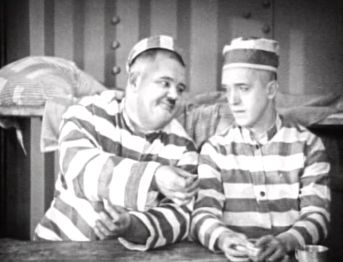 The real start of the Laurel and Hardy era. Though both are still in character - Stan as 'Little Goofy', Ollie unnamed - and would be so again in occasional films to come, it's here that their value as a two-man team was finally realised, and they are utilised by the Hal Roach studios as a double act. From hereon in, James Finlayson's appearance in twenty-five further Laurel and Hardy films would be as their foil, rather than as an equal in billing. The stark rise in quality and vision is marked. Whereas before many of the shorts had been a series of loosely-linked events, often centring around multiple characters, here we share the journey of the two leads as they escape, literally paint the town, and then hijack a car... that's going back to the prison from where they came! The short was actually vital in the development of Stan's character and appearance. In order to convincingly look like prisoners, the duo had their heads shaved for real. When Stan's hair began to grow back it took on the upright stance that we see in the later movies, and produced such amusement that it was kept. Consider the earlier, shapeless Stan characters in his solos, or even in duo films like The Lucky Dog where he's still trying to find his character under a rigid centre parting. Here a freak occurrence leads by chance to the further development of one of the funniest onscreen partnerships of all time.     (June 1927, 17m) Director: Clyde Bruckman Released: MGM, October 15, 1927 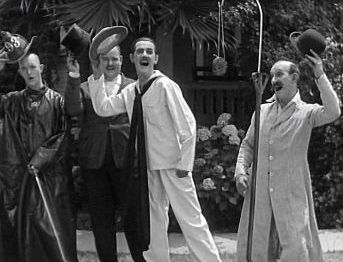 Stan and Ollie are merely guests in a Max Davidson comedy here, but this time as 'guest stars' rather than jobbing actors. Now completely operating as a team - and with their hair still growing back from the previous short - they appear alongside Charlie Chase and James Finlayson, improvising some bits of business as noisy next door neighbours. There's some nice comedy as Davidson's family move into a badly-installed house, but this isn't really of any great interest beyond that of a curio for Laurel and Hardy fans. Call of the Cuckoo was made during Davidson's fifteenth year in films, at a time when he had nearly 120 shorts to his name. A German actor from Berlin who had emigrated to America in the 1890s, Davidson had worked with both Laurel and Hardy on a number of occasions beforehand. While Hardy had appeared alongside him in three prior shorts, Stan had written or co-written four shorts with Davidson and later co-directed him in 1927's Flaming Fathers. Perhaps the most significant entry for Laurel and Hardy fans though came with 1927's Why Girls Say No, a two-reeler written by Stan and featuring Davidson alongside Oliver Hardy.    (July/August 1927, 20m) Director: Hal Yates Released: MGM, November 5, 1927 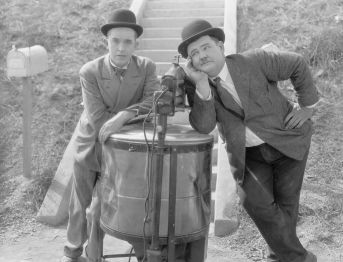 The first film where the duo are credited by their own names instead of character names, Hats Off received particularly positive reviews for a Laurel and Hardy movie and would later go on to be reworked as The Music Box. Sadly it remains the only completely missing Laurel and Hardy story, with only snapshots (as seen above) left to illustrate it. (August 1927, 19m) Director: Clyde Bruckman Released: MGM, December 3, 1927 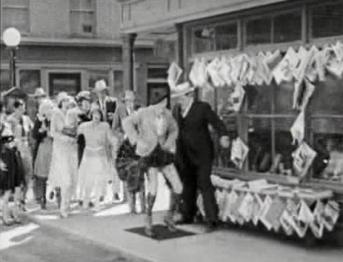 After the progression of the previous pictures, Laurel and Hardy strangely go back to a full character piece here, Hardy as the pompous J. Piedmont Mumblethunder, Stan as his highly-sexed Scottish nephew Philip. Here the duo return to the slightly risqu� elements of their act as they had done five months earlier: Philip is a sex pest, objects to having his inside leg measured, and, over twenty-five years before Marilyn Monroe, gets his kilt blown up by standing over sidewalk gratings. In this case, Philip's underwear has fallen down, the resulting (unseen) spectacle causing two female onlookers to faint. Though the basic premise is slight, it's a very funny movie and they milk that premise to its full worth, making you wonder how good they could have been not as 'Stan and Ollie'. Also of note in these early films are the street scenes, teaming with extras. They're wonderfully evocative of 1920s Americana, huge expansive streets and people full of hope for the future, completely unaware of what was just around the corner...     (September/October 1927, 19m) Director: Clyde Bruckman Released: MGM, December 31, 1927 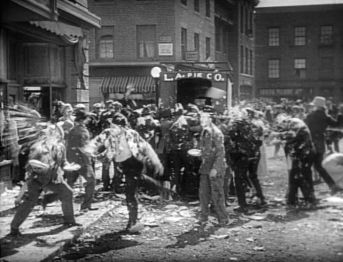 The Battle of the Century acts as a perfect example of how quickly shorts were getting made in the 1920s. One of the most famous boxing matches in history had just taken place, where Jack Dempsey knocked down reigning heavyweight champion Gene Tunney in the seventh round. Dempsey failed to return to a neutral corner, thus giving Tunney a long 14-second count, allowing him to recover and win the bout. The Dempsey-Tunney bout (actually titled 'The Battle of the Century') took place on September 22nd... this short - hilariously sending it up with Stan's 'Canvasback Clump' unsure what to do after getting a freak KO - was completed by October and released on December 31st 1927. The rapid inclusion of this was possibly due to Stan himself, who wrote to two fans in 1959 that 'I'm quite a fan of this sport, never miss seeing them, they really thrill me, especially when they are for the Championship Title.' One of the key factors cited when people express love for Laurel and Hardy is the characters' love for each other. That's absent here, with Ollie a manipulative manager who takes out an insurance policy on 'Canvasback' and henceforth tries to get him injured in order to cash in. When I wrote this review in 2009 the second reel was missing, with my original wording giving the information that it was "only partially complete in the archives, most of the resulting custard pie fight (with a record of over 4000 pies) still existing only because highlights from it were featured in Robert Youngson's 1965 documentary Laurel and Hardy's Laughing 20's." Thankfully this is no longer the case, as the entire second reel was found in 2015, though has yet to be commercially released. The short isn't still complete, as a scene where Ollie buys life insurance for Stan is still extant from the first reel, but with the entire second half of the film now found and in the archives, this is a real bonus for Laurel and Hardy fans, and gives hope that one day more may be found.     (October 1927, 21m) Director: Clyde Bruckman Released: MGM, January 28, 1928 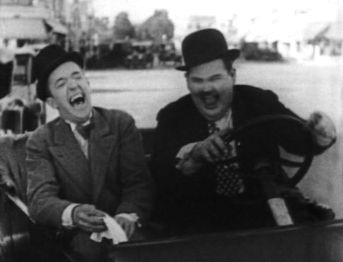 Visually Leave 'Em Laughing is now one of the most famous Laurel and Hardy films, with the sweet image of Stan in bed with toothache featuring every week as a poster in Ross and Joey's apartment in hit sitcom Friends. With all the remade/reused elements from the silents into film it's surprising that Leave 'Em Laughing wasn't chosen for an overhaul in the sound era. Stan and Ollie laughing helplessly became a much-loved device in many of their films (most notably Blotto and Them Thar Hills) and Leave 'Em Laughing contains the bizarre sight of the duo in laughing-gas induced hysteria... without sound. Although essentially plotless (Stan goes to get a tooth pulled at the dentist, during which both he and Ollie are subjected to laughing gas and roar helplessly while causing a traffic pile-up on the way home) the two-reeler establishes some of the key ingredients of Laurel and Hardy's work. There's the first signs of characters not inflicting straightforward violence upon one another, as with previous entries, but inflicting violence, then waiting their turn as their opponent takes a retaliatory strike. It's an artificial reaction, most famously taken to its extremes in the later Big Business, whereby a character will stand and simply watch as harm is reigned upon his person or property, almost politely indulging the perpetrator until their time to exact revenge arrives. The author John McCabe termed the act 'reciprocal destruction' and it begins in a small dose here, with a slowly orchestrated fight between the two leads and landlord Charlie Hall. Here a fight isn't a frantic scrabbling for supremacy but a laboured game of one-upmanship, a great starting point for mildly surrealist comedy. Another first is that Leave 'Em Laughing is the first film in which Laurel and Hardy wilfully share a bed. Although they were forced to co-habit by circumstance in Slipping Wives, back then it was as two combative characters who had only the other's misfortune in mind... here it's as two close friends there to care for one another. Though one may wonder what their landlord thinks of the situation, there's never any insinuation of anything more here, merely two very close friends sharing sleeping space by necessity. Hardy's protective stance over Stan, gently reassuring him through his pain, is touching, and a moment where he thinks that Stan has wet the bed (which turns out to be Stan's spilt hot water bottle) accentuates the concept that Hardy is protecting his man-child associate, a man emotionally unable to defend himself from the real world outside. Finally, Leave 'Em Laughing also marks the first association of the boys with Edgar Kennedy. A prolific actor of the medium who began in 1911's Brown of Harvard and would go on to appear in over 400 movies, Kennedy appeared in nine more Laurel and Hardy films up to 1930. In 1943 he made a one-off reappearance in the range with MGM's Air Raid Wardens. Kennedy had also been a director since 1922, and went on to direct two Laurel and Hardy silents two months later, From Soup To Nuts and You're Darn Tootin'.     (November/December 1927, 19m) Director: Clyde Bruckman Released: MGM, February 25, 1928 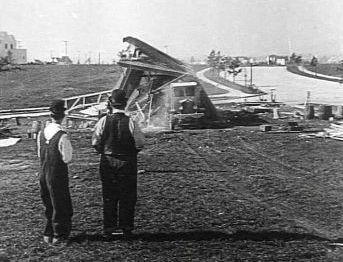 A formless but ultimately diverting short with Stan and Ollie as the world's most inept builders. Stan's love of surrealist humour, reputedly disliked by Hal Roach, can be witnessed in a scene where Stan carries an extra long plank of wood past a policeman (Edgar Kennedy)... with Stan holding onto both ends. The same vein of humour would branch out into bodily distortion, such as the duo having their legs wrapped around their necks, being skinned alive or transformed into animals. The joke was actually reprised from Stan's first short with James Finlayson, The Noon Whistle (1923) and would later be repeated in the Fox movie Great Guns.    (December 1927/January 1928, 18m) Director: E. Livingston Kennedy Released: MGM, March 24, 1928 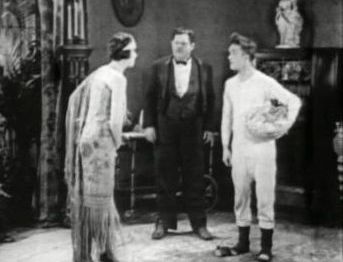 While having Stan and Ollie as waiters at a society dinner is an inspired premise, From Soup To Nuts emerges as one of the duo's weakest efforts. After they arrive for work what follows is a series of generic slapstick taking the most direct and predictable route towards the payoff: Ollie walking into a room carrying a large cream cake will see a banana skin on the floor in front of him; Hardy bending over will cause his trousers to tear; and Stan being told to bring in a salad undressed will result in the most literal misunderstanding causing Stan to emerge wearing only his night clothes while serving said food. However, one important development here is in Stan's readiness to recycle material and improve upon it, with a cherry-chasing scene that was lifted and expanded from The Second Hundred Years. In keeping with this theme, then when the entire short was reworked as the beginning of A Chump At Oxford it was made far funnier than here. Not only did the verbal element add much, but things like Stan stripping were made more logical because the character was drunk in the later movie. It's not, I feel, over-analysing the mechanics of comedy to expect there to be a logical reason behind each set up joke: having someone throw a banana on the floor in a society dinner ball is just too contrived and unlikely an occurrence to be genuinely funny, and that's the problem with From Soup To Nuts all over. Incidentally, the quality of the Hal Roach films, particularly the early silents, is highly variable, and some have shown severe damage and fading. This is illustrated above with a capture from the DVD release which is notably 'softer' than the majority of the other images on this site.  
| ||||||||||||||||||||||||||||||||||||||||||||||||||||||||||||||||||||||||